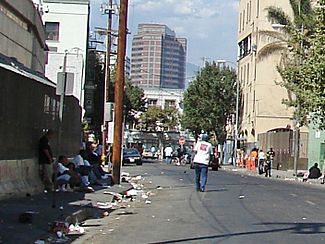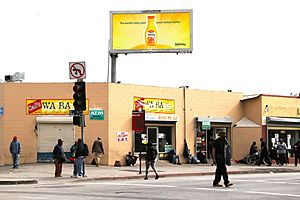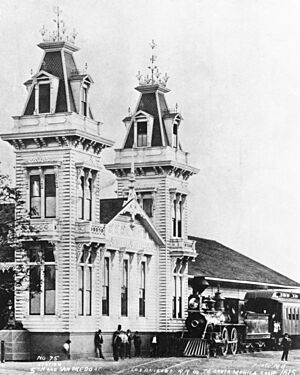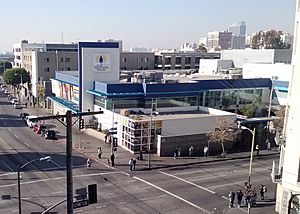Skid Row, Los Angeles facts for kids
Quick facts for kids
Skid Row
Central City East
|
|
|---|---|

San Julian Street south of 5th Street, 2006
|
|
| Country | United States |
| State | California |
| County | Los Angeles |
| City | Los Angeles |
| Area | |
| • Total | 0.431 sq mi (1.12 km2) |
| ZIP Code |
90013
|
| Area code(s) | 213 |
Skid Row is a neighborhood in Downtown Los Angeles. It is also known as Central City East. This area is known for having one of the largest groups of homeless people in the United States. Since the 1930s, many people without homes have lived here.
Skid Row covers about fifty city blocks. It is located just east of downtown Los Angeles. Its borders are Third Street to the north, Seventh Street to the south, Alameda Street to the east, and Main Street to the west.
Contents
What Does "Skid Row" Mean?
The name "skid row" comes from a term used in logging. Loggers would slide logs down "skid roads" made of greased logs. Workers would wait at the bottom of these roads. Over time, the term "skid row" began to describe city areas where people with little money gathered. It became a common name in North America for a struggling part of a city.
Who Lives in Skid Row?
In 2019, the people living in Central City East were from many different backgrounds. About 40% were Black/African American, and 22% were White. Around 16% were Asian, and 15% were Hispanic or Latino. There were also smaller groups of Native American, Pacific Islander, and people of mixed races.
Most residents, about 53%, were born in California. Another 27% were born in other U.S. states. About 19% were born in other countries.
The population was estimated to be around 10,580 people. In 2023, studies suggested the population grew by 13% after the COVID-19 pandemic. Most residents were adults, with about 61% aged 25 to 54. The average age for men was 50.9 years, and for women, it was 50.3 years. About 10% of the population were veterans.
The average income for households in Skid Row was much lower than in other parts of Los Angeles. In 2019, about 69% of the people lived below the poverty line.
A Look at History
Early Days (1880s-1960s)
In the late 1800s, many hotels opened in Skid Row. These hotels served workers who moved around for seasonal jobs. By the 1930s, about 10,000 people, many of them homeless, lived in Skid Row. The area had places like hotels, movie theaters, and cheap restaurants. It also offered social services, which drew people in need.
In 1947, the Los Angeles Police Department (LAPD) tried to clear out Skid Row. They arrested over 350 people. In the 1950s, the city started a plan to improve Skid Row by tearing down old buildings. They believed this would save money on social services. Many residential hotels were torn down because it was cheaper than fixing them. This meant many people lost their affordable homes and became homeless.
Changes in the 1970s
In 1976, city officials decided that Skid Row would be a place where homeless shelters and services would be allowed. This made it an unofficial "containment zone."
During the 1970s, two Catholic Workers, Catherine Morris and Jeff Dietrich, started a "Hippie Kitchen." They used a van to feed people. They continued this work for over forty years.
Many Vietnam veterans came to Skid Row in the 1960s and 1970s. They found services there and felt out of place elsewhere. This led to a shift in who lived in Skid Row.
Efforts to Help (2000s-Present)
In 2002, the LAPD tried to enforce an old rule against sleeping on sidewalks. This led to a lawsuit by the American Civil Liberties Union (ACLU). In 2006, a court ruled that the city could not arrest people just for sleeping on public sidewalks in Skid Row.
The city later agreed to a compromise. People could sleep on sidewalks between 9:00 p.m. and 6:30 a.m., but not within 10 feet of a business or home entrance.
The Safer Cities Initiative started in 2006. It sent more police officers to Skid Row to enforce rules more strictly. The goal was to reduce crime. While crime rates did go down, some studies suggested that more arrests also led to more people becoming homeless. Activists argued that tickets and arrests made it harder for people to find housing and jobs.
In 2012, the Skid Row Running Club was started by a judge, Craig Mitchell. This club helps improve the lives of people in the area. A documentary called "Skid Row Marathon" was made about the group.
In 2019, the city agreed to let people keep more of their belongings on the street. However, items that threaten public safety or are very large can still be taken away. Important items like medicine must be available for pick-up quickly.
During the COVID-19 pandemic, Skid Row faced new challenges. It was hard to keep the area clean because people had to take down their tents during the day. Also, public restrooms and gyms closed, making hygiene difficult. To help, city officials set up hand washing stations and mobile shower trucks. Recreation centers were also turned into shelters.
Art and Culture in Skid Row
Skid Row is home to many artists. It is near the Historic Core and the Arts District. This means Skid Row often hosts events that involve different neighborhoods.
In 2019, a group called the Los Angeles Poverty Department started offering theater classes and performances. They help residents express themselves through art. A journalist noted that the performances made audience members feel like family. The group also hosts the Festival for All Skid Row Artists every year.
The "Skid Row City Limits Mural" was created by volunteers. It shows how the community feels about their neighborhood's history and present. The "Dear Neighbor Mural" is another art piece that supports the idea of housing for everyone. Skid Row Karaoke is a weekly tradition where residents can sing and have fun.
Cool Places to See
- Star Apartments: This is a housing complex that opened in 2012. It was built especially for the needs of people experiencing homelessness.
- Indian Alley: This is an unofficial name for a part of Werdin Place. It was important for American Indians who were struggling in the 1970s to 1990s.
- The Skid Row City Limits Mural: This large mural was created in 2014. It shows a map of Skid Row's official borders and a sign saying "Skid Row City Limit, Population: Too Many." It was made by activists and residents to show community pride and spark conversations.
In Popular Culture
Skid Row has appeared in many movies and TV shows. These include The Sting, Starsky & Hutch, and Quincy, M.E..
Music videos for Michael Jackson's songs "Beat It" and "The Way You Make Me Feel" were filmed here. The band U2 also performed "Where the Streets Have No Name" on a rooftop in Skid Row for their music video. This performance was a nod to the Beatles' last concert.
The 2015 album Skid Row by electronic musician James Ferraro is also about this area.
Notable People
- Charles Bukowski: A famous writer who spent time in Skid Row when he was young. He found inspiration for his books there.
- Danny Harris: An Olympic hurdler and silver medalist.
- Nathaniel Ayers: A talented musician trained at Juilliard. He later experienced homelessness and mental health challenges. His story was told in the 2009 movie The Soloist.
- Lil Peep (Gustav Elijah Åhr, 1996-2017): A rapper and singer who lived in Skid Row for a period.






